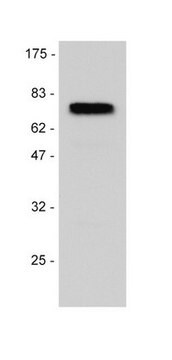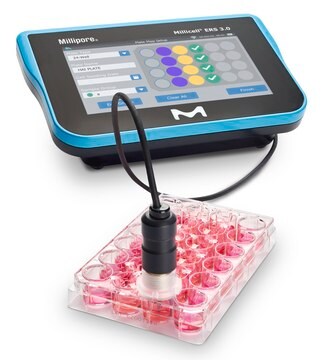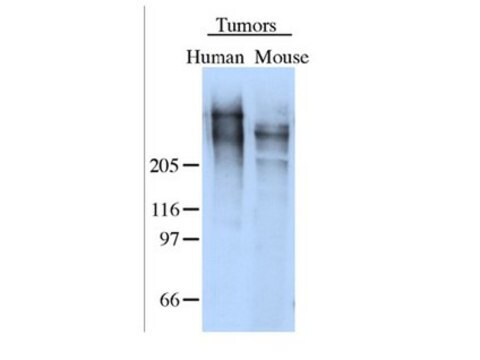ABN1655
Anti-p75NTR Antibody, ICD
serum, from rabbit
Sinonimo/i:
Tumor necrosis factor receptor superfamily member 16, CD271, Gp80-LNGFR, Low-affinity nerve growth factor receptor, Low affinity neurotrophin receptor p75NTR, NGF receptor, p75 ICD
About This Item
Prodotti consigliati
Origine biologica
rabbit
Livello qualitativo
Forma dell’anticorpo
serum
Tipo di anticorpo
primary antibodies
Clone
polyclonal
Reattività contro le specie
chicken, mouse, human, rat
tecniche
immunocytochemistry: suitable
immunofluorescence: suitable
immunoprecipitation (IP): suitable
western blot: suitable
N° accesso NCBI
N° accesso UniProt
Condizioni di spedizione
ambient
modifica post-traduzionali bersaglio
unmodified
Informazioni sul gene
rat ... Ngfr(24596)
Descrizione generale
Specificità
Immunogeno
Applicazioni
Immunofluorescence Analysis: A representative lot localized p75ICD immunoreactivity in cryosections from various stages of chick embryos fixed with 4% paraformaldehyde and permeabilized by 0.1% Triton X-100 (López-Sánchez, N., et al. (2007). Physiol. Genomics. 30(2):156-171).
Immunoprecipitation Analysis: A representative lot co-immunoprecipitated NRIF with p75 from rat sympathetic neurons. Co-immunoprecipitation of exogenously expressed NRIF and p75 by this antiserum was also seen using 293 transfectant. Increased CTF and ICD fragments were immunoprecipitated from PMA-treated 293 transfectants and from BDNF-treated neurons (in the presence of proteasome inhibitor). Co-treatment with gamma-secretase inhibitor abolished ICD, but not CTF cleavage in PMA- and BDNF-treated cells (Kenchappa, R.S., et al. (2006). Neuron. 50(2):219-232).
Western Blotting Analysis: A representative lot detected p75 in rat sympathetic neurons. Increased ~30 kDa CTF and ~25 kDa ICD fragments were detected from BDNF- or PMA-, but not NGF-, treated neurons (in the presence of proteasome inhibitor). Co-treatment with gamma-secretase inhibitor abolished ICD, but not CTF cleavage in BDNF-treated cells (Kenchappa, R.S., et al. (2006). Neuron. 50(2):219-232).
Western Blotting Analysis: A representative lot detected p75 in superior cervical ganglia (SCG) whole tissue lysate from P4 and P24 postnatal rats. CTF and ICD fragments were detected only in P4, but not P24 SCG lysate (Kenchappa, R.S., et al. (2006). Neuron. 50(2):219-232).
Neuroscience
Qualità
Western Blotting Analysis: A 1:5,000 dilution of this antiserum detected the ~25 kDa p75NTR (neurotrophin receptor) ICD fragment in 10 µg of mouse retina tissue lysate.
Descrizione del bersaglio
Stato fisico
Stoccaggio e stabilità
Handling Recommendations: Upon receipt and prior to removing the cap, centrifuge the vial and gently mix the solution. Aliquot into microcentrifuge tubes and store at -20°C. Avoid repeated freeze/thaw cycles, which may damage IgG and affect product performance.
Altre note
Esclusione di responsabilità
Non trovi il prodotto giusto?
Prova il nostro Motore di ricerca dei prodotti.
Codice della classe di stoccaggio
12 - Non Combustible Liquids
Classe di pericolosità dell'acqua (WGK)
WGK 1
Punto d’infiammabilità (°F)
Not applicable
Punto d’infiammabilità (°C)
Not applicable
Certificati d'analisi (COA)
Cerca il Certificati d'analisi (COA) digitando il numero di lotto/batch corrispondente. I numeri di lotto o di batch sono stampati sull'etichetta dei prodotti dopo la parola ‘Lotto’ o ‘Batch’.
Possiedi già questo prodotto?
I documenti relativi ai prodotti acquistati recentemente sono disponibili nell’Archivio dei documenti.
Il team dei nostri ricercatori vanta grande esperienza in tutte le aree della ricerca quali Life Science, scienza dei materiali, sintesi chimica, cromatografia, discipline analitiche, ecc..
Contatta l'Assistenza Tecnica.





